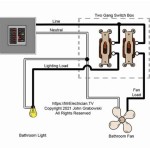How To Replace a Bathroom Fan Cover: A Comprehensive Guide
A bathroom fan plays a crucial role in maintaining air quality and preventing moisture build-up, which can lead to mold and mildew growth. The fan cover serves to protect the internal components, filter dust and debris, and provide a more aesthetically pleasing appearance. Over time, bathroom fan covers can become damaged, discolored, or simply outdated. Replacing a bathroom fan cover is a relatively straightforward task that can significantly improve the functionality and appearance of the bathroom. This article provides a detailed, step-by-step guide on how to replace a bathroom fan cover safely and effectively.
Before beginning any work, it is essential to prioritize safety. Electricity and water are a dangerous combination, and working on electrical components, even seemingly simple ones, requires caution. Make sure to follow all the instructions outlined below and if there are any concerns or doubts about the process, consult a qualified electrician or handyman.
Key Point 1: Preparation and Safety Precautions
Proper preparation is paramount to a successful and safe fan cover replacement. This stage involves gathering the necessary tools and materials, turning off the power to the fan circuit, and taking precautions to avoid injury.
Gather Necessary Tools and Materials: The following tools and materials will be required for the replacement process:
- New bathroom fan cover (ensure it is compatible with the existing fan model)
- Screwdriver (Phillips head or flathead, depending on the cover's fasteners)
- Step ladder or sturdy stool (if the fan is out of reach)
- Gloves (optional, for added protection and hygiene)
- Safety glasses (to protect eyes from debris)
- Dust mask (to prevent inhalation of dust and mold spores)
- Vacuum cleaner with brush attachment (for cleaning the fan housing)
Turn off the Power: This is the most critical safety step. Locate the circuit breaker that controls the bathroom fan and switch it to the "off" position. To confirm that the power is indeed off, test the fan switch or use a non-contact voltage tester before proceeding. This eliminates the risk of electrical shock during the replacement process. Do not skip this step. It is essential to ensure the electricity is disconnected to avoid severe injury.
Inspect the Area: Before starting the removal, visually inspect the old fan cover and the surrounding area. Check for any signs of damage, such as cracks, broken clips, or loose wiring. If there are any obvious electrical issues, such as exposed wires or burnt components, it is advised to consult a qualified electrician before proceeding. Document the existing configuration, especially how the old cover is attached, which will aid in the installation of the new cover.
Personal Protective Equipment: While not always crucial, wearing safety glasses and a dust mask will protect against any dust, debris, or mold spores that may be released during the removal and cleaning process. Gloves can also be used for added protection and hygiene.
Key Point 2: Removing the Old Fan Cover
The method for removing the old fan cover will vary depending on the model and how it is attached. Most covers are held in place by either spring clips, screws, or a combination of both. Careful observation will help to identify the appropriate removal technique.
Identifying the Attachment Mechanism: Examine the old cover closely to determine how it is attached. Spring clips are usually visible as small metal or plastic tabs located on the inside of the cover. Screws are typically located on the outside of the cover, either along the edges or in the center. Some covers may have a combination of both.
Removing Covers with Spring Clips: If the cover is held in place by spring clips, gently push up on the cover until the clips are visible. Then, carefully squeeze the clips together and pull the cover down. It may be necessary to use a small screwdriver to help release the clips if they are stuck or corroded. Work slowly and carefully to avoid breaking the clips, as this can make removal more difficult. Try to work on opposite sides of the cover simultaneously to ensure the cover comes down evenly.
Removing Covers with Screws: If the cover is held in place by screws, use the appropriate screwdriver to loosen and remove the screws. Keep the screws in a safe place, as they may be needed to install the new cover. Once all the screws are removed, the cover should come down easily. If the cover is stuck, gently pry it loose with a flathead screwdriver, being careful not to damage the surrounding ceiling.
Removing Covers with a Combination of Clips and Screws: In some cases, the cover may be held in place by a combination of spring clips and screws. Remove the screws first and then follow the procedure for removing covers with spring clips. Document the position of the screws before removal to aid during reassembly.
Cleaning the Fan Housing: Once the old cover has been removed, use a vacuum cleaner with a brush attachment to clean the fan housing and surrounding area. Remove any dust, debris, or mold spores that may have accumulated over time. This will improve the fan's performance and prevent the spread of allergens. Pay particular attention to the fan blades, motor, and ventilation ducts. A clean fan will operate more efficiently and quietly.
Key Point 3: Installing the New Fan Cover
Installing the new fan cover is generally the reverse of the removal process. Ensure proper alignment and secure attachment for optimal functionality and a professional finish.
Aligning the New Cover: Carefully align the new fan cover with the fan housing. Make sure that the cover is oriented correctly and that any clips or screw holes are properly aligned. If the cover has a specific direction, pay attention to any markings or labels.
Attaching Covers with Spring Clips: If the new cover is held in place by spring clips, gently push the cover up into the fan housing until the clips snap into place. Ensure that all the clips are securely engaged and that the cover is flush with the ceiling. If the clips are difficult to engage, try slightly bending them outwards to make them easier to compress. Do not force the cover, as this can damage the clips or the cover itself.
Attaching Covers with Screws: If the new cover is held in place by screws, align the cover with the screw holes in the fan housing and insert the screws. Tighten the screws until the cover is securely attached, but do not overtighten them, as this can strip the screw holes or damage the cover. Use the same screws that were removed from the old cover, if possible. If new screws are needed, make sure they are the correct size and type.
Attaching Covers with a Combination of Clips and Screws: If the new cover is held in place by a combination of spring clips and screws, attach the clips first and then insert and tighten the screws. This will ensure that the cover is securely attached and properly aligned.
Testing the Installation: Once the new cover is installed, turn the circuit breaker back on and test the fan to make sure it is working properly. Listen for any unusual noises or vibrations. If the fan is not working or is making strange noises, double-check the installation and ensure that all the connections are secure. If the problem persists, consult a qualified electrician.
Final Inspection: After confirming that the fan is working properly, perform a final inspection of the installation. Make sure that the cover is securely attached and that there are no gaps or loose edges. Clean up any debris or tools that may have been left behind. Dispose of the old fan cover properly. A well-installed fan cover will improve the appearance of the bathroom and help to maintain good air quality.
Replacing a bathroom fan cover is a simple yet effective way to improve the functionality and aesthetics of the bathroom. By following these detailed instructions and taking the necessary safety precautions, individuals can successfully complete this project and prevent mold and mildew. Regular maintenance and timely replacement of the fan cover are essential for maintaining a healthy and comfortable bathroom environment.

Remove Install A Bathroom Fan Grille In 1 Min

How To Replace Bathroom Exhaust Fan Cover

Update An Existing Bathroom Exhaust Fan Cover Remodelaholic

Tips For Installing Or Replacing A Bathroom Fan Forbes Home

How To Clean Replace Light Broan Model 678 Exhaust Fan

How To Install A Bathroom Fan Homeserve Usa

How To Install A Bathroom Fan Step By Guide Bob Vila

How To Replace A Bathroom Fan Motor Quick Diy Approach

How To Replace A Bathroom Exhaust Fan Without Attic Access 12 Step Guide Home Inspector Secrets

Update An Existing Bathroom Exhaust Fan Cover Remodelaholic
Related Posts







